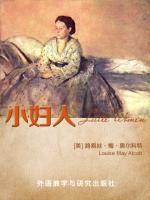Book Review of Little Women
19305010陈俭贞
Little Women Louisa May Alcott Bantam Classics 1983-4-1 Below is
a book review of Little Women, a family ethics novel with autobiographic
color written by Louisa May Alcott, an American female author in 19th
century, and published by Bantam Classics on April 1st 1983. This book
review consists of three parts, incorporating a brief synopsis of the
book content, an analysis of the main characters and an interpretation
of the themes of the book. Based on the author’s early life in New
England, Little Woman vividly depicts the growing process of the four
March sisters as they grow from girls to little women, recounting their
unique love experiences and respective pursuit of different ideals. The
story takes place during the American Civil War when Father March, the
only male in the March family is away with the Union army. Nevertheless,
though faced with financial hardship, the four March sisters, Meg, Jo,
Beth and Amy keep in high spirits with their mother, Mrs. March or
“Marmee” and support each other, showing tremendous vigor of youth and
passion for life. Not bound by the traditional etiquette, the four March
sisters dare to love, live as they please optimistically and pursue
their inner dreams. At the end of the tale, with beautiful feminine
qualities and the persistent seek, March sisters respectively find their
true love, achieve their own life goals and realize the value of life.
To sum up, it is a novel about the independent growth of females.
The four March sisters has significantly different characters though all
of them are pretty, kind and sincere. As the most important character in
the novel, Jo is an open-minded, self-respecting and tenacious tomboy,
acting as the inner-directed leader of the March sisters. Keen on and
gifted in literary creation, Jo bravely heads to New York to pursue her
dream of being a successful writer after refusing the proposal of her
rich neighbor Laurie, which reflects the strength of women in careers.
As for Meg, the oldest one in the family, is of a gender nature. Though
she is slight weakness for leisure, she marries to the poor John without
hesitation for his integrity and loyalty. The glory of maternal love and
the wisdom of family arrangement shining on Meg manifests the
traditional virtues of women. The third sister, Beth, is introverted and
docile. Because she could not adapt to the school life, she drops out of
school and stays at home helping Mrs.March with domestic work and taking
care of her sisters. She gives all her unconditional love to the family
and the weak and has no regrets even though contracting scarlet disease
for delivering food to her poor neighbors. The peace and serenity with
which she faced death moves readers to tears. The youngest sister Amy is
fond of experimenting with art and has an aesthetic taste for painting
and sculpture. She dreams of becoming a great artist and makes
unremitting efforts to this end, without doubting her ability even
though she is ridiculed by setbacks. Despite a bit of vanity, her
sympathy for the poor drives her to devote herself to charity after
marrying rich Laurie. Frankly speaking, not each of the March sisters is
perfect, but the beautiful qualities they carry with when seeking and
chasing for life ideals matters much more than the shortcomings. As the
sayig goes, gold can not be pure and man can not be perfect. The
characters of March sisters is actually a true portrait of real life and
humanity. The themes of Little Woman focus on family, poverty,
self-improvement and independence of females. To begin with, throughout
the novel, the author emphasizes the March sisters’ familial reactions
and behaviors toward each other to express the praise of the importance
and significant meaning of family. The March family is an inalienable
and interdependent whole where all the family members deeply care and
support one another. What’s more, to seek joy and be optimistic amidst
poverty and sorrow is another theme of the novel. In spite of the
relatively poor financial situation, instead of wallowing themselves in
the sadness of material deprivation, the March sisters work hard as
tutors to support the family. Instead of complaining about the lack of
exquisite decorations and gorgeous clothes, they frequently put on plays
written by Jo using whatever props are available, which brings great fun
to their commonplace life. Additionally, poverty does not stop the
spread of kindness. Due to Marmee’s education, it is so well-meaning and
generous of the March sisters to give away their precious Christian
dinner to their neighbors who are suffering hunger and disease. Last but
not least, self-improvement and independence is also a major theme of
the novel. The March sisters are always working to develop their
characters, learn form mistakes and step forward to their life ideals.
It is a growth process full of constant change. Along with
self-improvement, the March sisters attach great importance to
independence. Take for example, Jo thinks independence and freedom
overweigh wealth. Thus, she firmly refuses the proposal of rich Laurie.
In conclusion, as a book with regard to females, Little Women narrates
the growth story of the four March sisters with different but beautiful
characters, expressing the themes of family, poverty, self-improvement
and independence.



 京公网安备 11010802032529号
京公网安备 11010802032529号